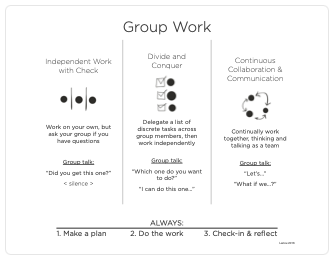What does it mean to “work as a group”?
“OK, now work on your worksheets as a group.”
Teachers frequently ask classes to work in groups to promote collaboration, to encourage problem-solving, and to expose students to multiple perspectives.
A snag about giving general directions to work in a group is that the concept of “working as a group” is pretty vague. Some students may have a schema for group work, and it may match the teacher’s expectation—but not necessarily! Unless we concretize and teach what we mean by group work, students can be left floundering and the work we hope to see might not happen.
What Do We Mean by “Group Work”?
Instead of leaving the concept of group work open for interpretation, we can specify how we expect student to work together in a group. There are a few distinct varieties of group work that we expect to see—even if we’re not aware of it:
There are some times when we want students talking, responding, and negotiating. This is common for assignments like preparing for a debate. This can be thought of as Continuous Collaboration & Communication.
There are other assignments we hope students will look at something together, but then divvy up the work and tackle it separately. Group posters and research project sometimes lend themselves to this type. This is like Divide and Conquer.
And then there are some tasks where we expect students to be able to check in with a classmate if they need help. Maybe an algebra practice worksheet would call for this kind of Independent Work with Check.
Types of Group Work
Independent Work with Check
Though this is the least group-y of the types of group work, it’s ok to structure group work that allows students to mostly work independently, but have a partner or small group to check in with.
When you distribute a practice worksheet in math, you usually don’t need students narrating every step of every problem: “So for number three you start by adding the numbers in the lefthand column which is sixteen, carry the one…”
Teach It
When you want your class to do Independent Work with Check, you can tell them clearly: “You’ll be mostly working on your own, but ask the members of your group if you have any questions or want to double-check an answer along the way.” If the room goes silent for an extended period of time, you may need to remind everyone that they should feel comfortable ask a group member to check in.
When introducing it for the first time, brainstorm with the class what this kind of group work might sound like. Usually it’s pretty quiet, but you may hear phrases like, “Did you get number six?”
Divide and Conquer
Some group projects are best tackled by divvying up the project into parts, working separately, and then coming back together.
If you give every group a list of research questions to answer, you may want to encourage students to discuss the questions together, then delegate the questions across group members and working independently.
Teach It
When you think Divide and Conquer is called for you can instruct your class: “There’s a lot to do for this project, so you’ll want to divide and conquer. When you get your paper, talk as a group about which questions each person will answer. Decide on one group facilitator who will write down who’s tackling which question, and I’ll give you ten minutes before the end of class to share out your answers and ask each other questions.” You might want to also provide a halfway check-in to encourage groups to pause their independent work and share with their group members what progress they’ve made.
When brainstorming with the class what they might hear or say during this kind of group work, you may get responses like, “Which one do you want to do?” or “I can do that part.”
Continuous Collaboration & Communication
This might be what we think we mean when we say “group work” but as we’ve seen it’s not often necessary for students to be talking continuously when doing group work.
But there are times when constant collaborative work is called for, when you want students thinking and talking as a team. This is a great type of group work to encourage when you want all students sharing their prepared responses, or contributing thoughts to a provocative question.
Teach It
We may assume students know what Continuous Collaboration and Communication looks like, but it requires explicit teaching and practice. Depending on the task and age of students, you may want to:
teach and practice turn-taking and how to ensure all voices are heard
introduce roles like facilitator, recorder, and time keeper with visual supports outlining the responsibilities
prepare students for the continual noise, providing voice volume reminders as well as offering headphones or a quiet location for students or groups who need it
This is not an exhaustive list, but hopefully a helpful starting point to be clearer about how we expect students to work together. What other types of group work do you think there are?
Teaching and Practicing Group Work
Be explicit about the type of group work you expect, and be sure to teach and review what that type of group work looks like. Try practicing with different types of activities, and over time have students identify the ones they feel best suited for. To incorporate choice and build autonomy, consider letting students choose what kind of group work at times, and other times challenge them to use one that’s less preferred.
To best structure the group work time, be sure to encourage groups to do these three things no matter the type of group work:
Make a plan
Do the work
Check-in & reflect
Clear expectations create predictability, and predictability is regulating, reassuring, and helps students feel confident and complete their work.
The more we say what we mean, teach explicitly and provide ongoing support, the smoother and more engaging our classrooms will be, and the more happy and successful students will feel.
Want to teach clear expectations for group work to your students…?






